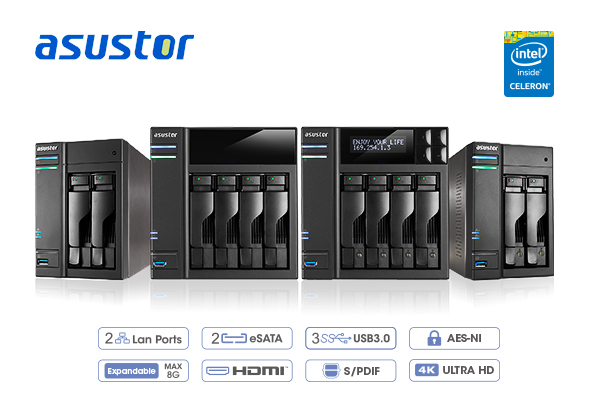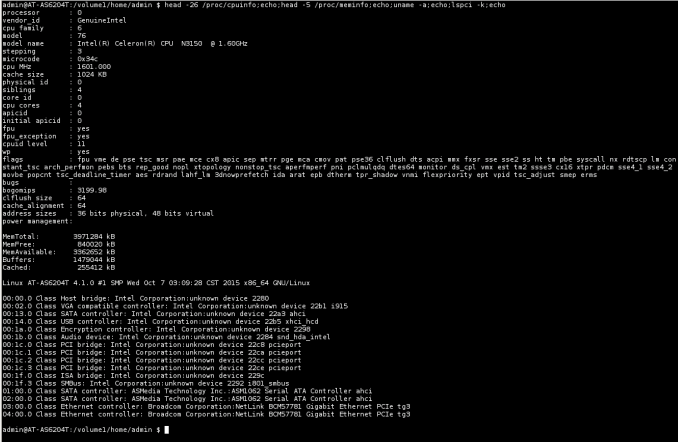Asustor AS6204T Braswell NAS Review
by Ganesh T S on November 5, 2015 8:00 AM EST
Asustor is one of the recent entrants in the NAS market. Over the last couple of years, they have tried to play in the same space as QNAP and Synology, targeting power users and SMBs. They have a wide variety of hardware platforms to choose from, ranging from ARM-based 2-bay systems to Xeon-based rackmounts. Asustor became the first COTS NAS (commercial off-the-shelf network-attached storage) vendor to introduce models based on Intel's 14nm Braswell SoCs back in September 2015. In this review, we take a look at the performance of the AS6204T, a 4-bay model.
Introduction and Testbed Setup
Asustor recently introduced ARM-based NAS models as well as an update to their Bay Trail models in order to serve both home consumers and SOHO / SMBs with better hardware platforms. Their Braswell lineup consists of four models, with each model name following the pattern AS6X0YT, where X (1 or 2) refers to the number of cores in the Braswell SoC in the model and Y (2 or 4) refers to the number of bays. The dual-core SoC used by Asustor is the Intel Celeron N3050, while the quad-core SoC is the Intel Celeron N3150. One of the more important updates in moving up from Bay Trail-based SoC such as the Celeron J1900 to the Braswell-based SoCs is the availability of AES-NI for accelerated encryption capabilities.
Asustor sampled us with the highest end model in the AS6xxx series, the AS6204T. The specifications of the Asustor AS6204T are provided in the table below. The corresponding specifications of some of the other contemporary NAS units are also included.
| Comparative NAS Configurations | ||
| Aspect | Asustor AS6204T | |
| Processor | Intel Celeron N3150 (Braswell 4C/4T Airmont x86 @ 1.6 GHz) | Intel Celeron N3150 (Braswell 4C/4T Airmont x86 @ 1.6 GHz) |
| RAM | 4 GB | 4 GB |
| Drive Bays | 4x 3.5"/2.5" SATA II / III HDD (Hot-Swappable) | 4x 3.5"/2.5" SATA II / III HDD (Hot-Swappable) |
| Network Links | 2x 1 GbE RJ-45 | 2x 1 GbE RJ-45 |
| External I/O Peripherals | 3x USB 3.0, 2x USB 2.0, 2x eSATA | 3x USB 3.0, 2x USB 2.0, 2x eSATA |
| Expansion Slots | None | None |
| Display Out | HDMI 1.4b | HDMI 1.4b |
| Power Supply | 90W (12V @ 7.5A) External Power Adapter | 90W (12V @ 7.5A) External Power Adapter |
| Full Specifications Link | Asustor AS6204T Specifications | Asustor AS6204T Specifications |
| Price (when reviewed) | USD 670 | USD 670 |
The various specifications of the NAS are backed up by the data gleaned via SSH access to the unit. The most interesting aspect here is the use of the Broadcom BCM57781 Ethernet controllers.
The industrial design of the Asustor units give us nothing to complain about. The LCD screen provides a quick way to look at and control the essential NAS configuration. The drive bays are solid and can take both 3.5" as well as 2.5" drives. The caddies also come with a basic locking mechanism to protect against accidental disk removal.
The setup process is quite straightforward. Upon connection to the network, the Asustor AS6204T receives a DHCP address even in a diskless state. The IP address can be determined either from the DHCP provider in the system or via the Asustor Control Center Windows / OS X utility. Starting off in a diskless state results in a prompt from the web UI to insert at least one disk in order to continue. The single disk can be configured in a JBOD volume and the login credentials can also be set up. The unit had no trouble in handling our standard RAID migration, expansion and rebuild operations using the 4TB WD Re drives.
In the rest of this piece, we will take a look at how the Asustor AS6204T takes advantage of the Braswell platform. We will be solely concentrating on objective metrics in this review. A discussion of the mobile apps, we UI and other subjective aspects will be covered in a future article. Benchmark numbers for both single and multi-client scenarios across a number of different client platforms as well as access protocols will be presented. We also have a separate section devoted to the performance of the NAS with encryption enabled. Prior to all that, we will take a look at our testbed setup and testing methodology.
Testbed Setup and Testing Methodology
The Asustor AS6204T can take up to 4 drives. Users can opt for either JBOD, RAID 0, RAID 1, RAID 5, RAID 6 or RAID 10 configurations. We expect typical usage to be with a RAID-5 volume. In order to keep things consistent across different NAS units, we benchmarked a RAID-5 volume with four Western Digital WD4000FYYZ RE drives were used as the test disks. Our testbed configuration is outlined below.
| AnandTech NAS Testbed Configuration | |
| Motherboard | Asus Z9PE-D8 WS Dual LGA2011 SSI-EEB |
| CPU | 2 x Intel Xeon E5-2630L |
| Coolers | 2 x Dynatron R17 |
| Memory | G.Skill RipjawsZ F3-12800CL10Q2-64GBZL (8x8GB) CAS 10-10-10-30 |
| OS Drive | OCZ Technology Vertex 4 128GB |
| Secondary Drive | OCZ Technology Vertex 4 128GB |
| Tertiary Drive | OCZ Z-Drive R4 CM88 (1.6TB PCIe SSD) |
| Other Drives | 12 x OCZ Technology Vertex 4 64GB (Offline in the Host OS) |
| Network Cards | 6 x Intel ESA I-340 Quad-GbE Port Network Adapter |
| Chassis | SilverStoneTek Raven RV03 |
| PSU | SilverStoneTek Strider Plus Gold Evolution 850W |
| OS | Windows Server 2008 R2 |
| Network Switch | Netgear ProSafe GSM7352S-200 |
The above testbed can run up to 25 Windows 7 or CentOS VMs simultaneously, each with a dedicated 1 Gbps network interface. This simulates a real-life workload of up to 25 clients for the NAS being evaluated. All the VMs connect to the network switch to which the NAS is also connected (with link aggregation, as applicable). The VMs generate the NAS traffic for performance evaluation. However, keeping in mind the nature of this unit, we restricted ourselves to a maximum of 10 simultaneous clients.
Thank You!
We thank the following companies for helping us out with our NAS testbed:
- Thanks to Intel for the Xeon E5-2630L CPUs and the ESA I-340 quad port network adapters
- Thanks to Asus for the Z9PE-D8 WS dual LGA 2011 workstation motherboard
- Thanks to Dynatron for the R17 coolers
- Thanks to G.Skill for the RipjawsZ 64GB DDR3 DRAM kit
- Thanks to OCZ Technology for the two 128GB Vertex 4 SSDs, twelve 64GB Vertex 4 SSDs and the OCZ Z-Drive R4 CM88
- Thanks to SilverStone for the Raven RV03 chassis and the 850W Strider Gold Evolution PSU
- Thanks to Netgear for the ProSafe GSM7352S-200 L3 48-port Gigabit Switch with 10 GbE capabilities.
- Thanks to Western Digital for the eight WD RE hard drives (WD4000FYYZ) to use in the NAS under test.












29 Comments
View All Comments
Der2 - Thursday, November 5, 2015 - link
Nas life.zeeBomb - Thursday, November 5, 2015 - link
I have heard a lot about these surverlliance stations for quite some time now...appears to be the next big thing. Thank YOU for delivering these results!asendra - Thursday, November 5, 2015 - link
I'm hoping Sinology releases in 2016 a 4bay braswell NAS, a DS416+ if you will, hopefully with a N3700. They have already announced some 2016 models with braswell, just not the ones I want.I would buy the current DS415+, but because I'm in no need of one right now, I just hope they get to it before I need to make the purchase.
galfert - Thursday, November 5, 2015 - link
I think the DS716+ is the device to get this year. No need to wait for a DS416+. If you need more than two drives you can get the 5 bay expansion model for the DS716+. That is why it is called a DS7xx+ model...because you can have 7 drives. So it is better than a DS4xx model which can't support the expansion module.For me the DS716+ is the device I've been waiting for. Powerful Intel CPU, Expandable RAM, Expansion module support, Transcoding of video, virtualization support, Hardware Encryption support. It has everything I need. Previously you had to compromize. I have a DS214play and a DS713+ and the DS716+ can replace both of them.
asendra - Friday, November 6, 2015 - link
You know, I hadn't considered that option. It would be a more expensive one, but it could work, in fact I could use a dx213 instead, wich gives me plenty storage for my needs.If when I need to buy one this next year they haven't released yet the new 4bay braswell ones, I might go with this option instead of the older ds415+.
Another thing I wanted to wait for so I could see how it develops It's Btrfs support.
DanNeely - Thursday, November 5, 2015 - link
Is the rebuild time graph showing numbers in seconds? Hours would be a lot more immediately meaningful. /3600 isn't a particularly easy mental computation.romrunning - Thursday, November 5, 2015 - link
Your article says: "Their Braswell lineup consists of four models, with each model name following the pattern AS6X0YT, where X (1 or 2) refers to the number of cores in the Braswell SoC in the model and Y (2 or 4) refers to the number of bays."Yet the Asustor AS6204T has 4 cores. So by your definition, it should have been named the "AS6404T".
So it sounds like your definition should be updated.
romrunning - Thursday, November 5, 2015 - link
Forget the above - the wording isn't as clear. I thought you were saying it was a direct relationship where the number = amount of cores. It could have been written that the second numeral denotes whether the CPU is dual-core (X=1) or quad-core (X=2).romrunning - Thursday, November 5, 2015 - link
This also reminds me - with today's advanced CMS/commenting systems, why can't we edit or delete our own comments on Anandtech??DanNeely - Thursday, November 5, 2015 - link
Which editor/reviewer do you want to furlough to hire a web developer to replace the comment system?